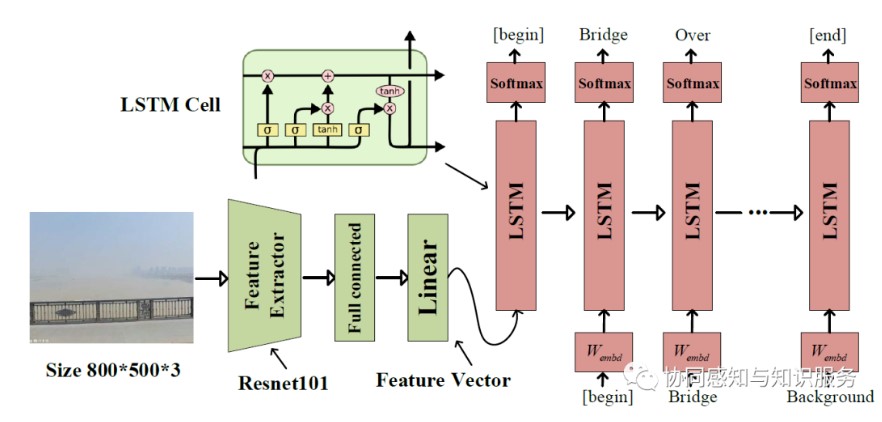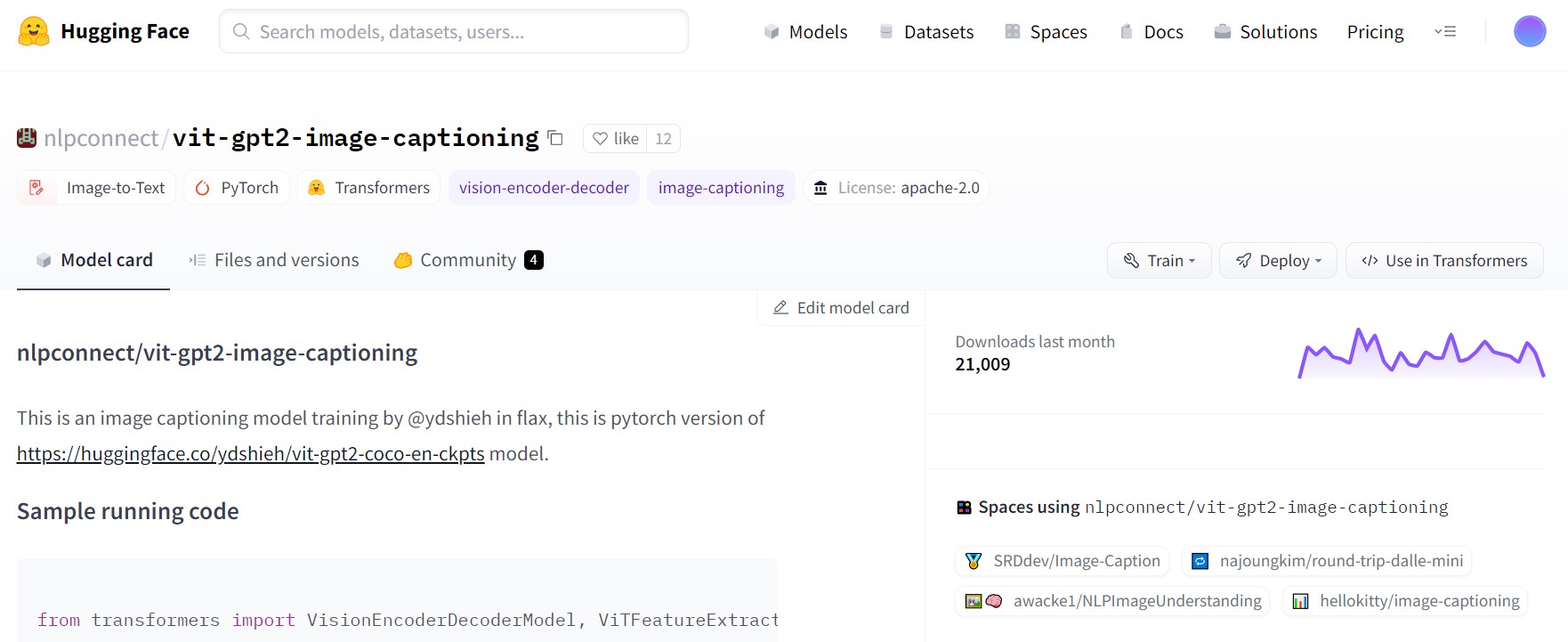Migratable urban street scene sensing method based on vision language pre-trained model
@article{ZHANG2022102989,
title = {Migratable urban street scene sensing method based on vision language pre-trained model},
journal = {International Journal of Applied Earth Observation and Geoinformation},
volume = {113},
pages = {102989},
year = {2022},
issn = {1569-8432},
doi = {https://doi.org/10.1016/j.jag.2022.102989},
url = {https://www.sciencedirect.com/science/article/pii/S1569843222001807},
author = {Yan Zhang and Fan Zhang and Nengcheng Chen}
}
微信公众号有该文章的详细推送,欢迎关注! https://mp.weixin.qq.com/s/m5IKEBE0ZLltLRBcgcxnwA
Using NLP For City Learning
jupyter notebook:https://github.com/yemanzhongting/CityCaption/blob/master/jupyter%20code/Captioning_street_view.ipynb
**Step1,**我们需要安装vqa-maskrcnn-benchmark的库
它可以提供基于pytorch的Faster R-CNN and Mask R-CNN算法
对其进行编译
!python setup.py build
!python setup.py develop
# Install maskrcnn-benchmark to extract detectron features
%cd /content
!git clone https://gitlab.com/vedanuj/vqa-maskrcnn-benchmark.git
%cd /content/vqa-maskrcnn-benchmark
# Compile custom layers and build mask-rcnn backbone
!python setup.py build
!python setup.py develop
import sys
sys.path.append('/content/vqa-maskrcnn-benchmark')
**Step2:**使用跨模态预训练模型
Annotation of multimodal data is extremely expensive, and the most prominent open source image caption datasets are as follows:
-
Microsoft COCO dataset (It is the most commonly used training resource for multi-modality, including indoor and outdoor environments, with over 1.5 million captions describing over 330,000 images).
-
Flickr30k dataset (It contains 31,000 images collected from Flickr platform, and 5 reference sentences provided by human volunteer, which are mainly from social media).
-
Google Conceptual Captions dataset (3 million images, paired with natural-language captions, mainly from Internet HTML pages).
The Microsoft Common Objects in Context dataset is the most widely applicable and is the one we use. This dataset consists of indoor and outdoor scene, 80 object classes, and 5 manually annotated descriptions for each image. Microsoft company invites volunteers to provide textual descriptions of every images and to cross-validate them.
image caption 架构
For the decoder part, the most common one is the Long short-term memory (LSTM) recurrent neural network; for the encoder part (green), there are three main methods: Resnet101 feature, Bottom-Up feature, and the vilbert feature (accuracy CIDEr=1.158,SPICE=0.2114).
The main difference between the three encoding methods is that Resnet101 is a 101-layer-deep convolutional neural network trained on more than one million images that could identify 1,000 object classes.
Bottom-Up method uses Faster R-CNN to extract image features, dividing the image into
Vilbert feature extracting method is a joint representation model for images and natural language.
加载预训练文件
# Download the models for feature extraction
%cd /content/
%mkdir model_data
# !wget -O /content/model_data/detectron_model.pth https://dl.fbaipublicfiles.com/pythia/detectron_model/detectron_model.pth
# !wget -O /content/model_data/detectron_model.yaml https://dl.fbaipublicfiles.com/pythia/detectron_model/detectron_model.yaml
!wget -O /content/model_data/detectron_model.pth wget https://dl.fbaipublicfiles.com/vilbert-multi-task/detectron_model.pth
!wget -O /content/model_data/detectron_model.yaml wget https://dl.fbaipublicfiles.com/vilbert-multi-task/detectron_config.yaml
Step3:实现图像文本的解译
使用到了opencv与yaml请自行安装
import yaml
import cv2
import torch
import requests
import numpy as np
import gc
import torch.nn.functional as F
import pandas as pd
import torchvision.models as models
import torchvision.transforms as transforms
from PIL import Image
from IPython.display import display, HTML, clear_output
from ipywidgets import widgets, Layout
from io import BytesIO
from maskrcnn_benchmark.config import cfg
from maskrcnn_benchmark.layers import nms
from maskrcnn_benchmark.modeling.detector import build_detection_model
from maskrcnn_benchmark.structures.image_list import to_image_list
torch._six.PY3 = True # fix for newer pytorch
from maskrcnn_benchmark.utils.model_serialization import load_state_dict
class FeatureExtractor:
TARGET_IMAGE_SIZE = [448, 448]
CHANNEL_MEAN = [0.485, 0.456, 0.406]
CHANNEL_STD = [0.229, 0.224, 0.225]
def __init__(self):
# self._init_processors()
self.detection_model = self._build_detection_model()
def __call__(self, url):
with torch.no_grad():
detectron_features = self.get_detectron_features(url)
return detectron_features
def _build_detection_model(self):
cfg.merge_from_file('/content/model_data/detectron_model.yaml')
cfg.freeze()
model = build_detection_model(cfg)
checkpoint = torch.load('/content/model_data/detectron_model.pth',
map_location=torch.device("cpu"))
load_state_dict(model, checkpoint.pop("model"))
model.to("cuda")
model.eval()
return model
def get_actual_image(self, image_path):
if image_path.startswith('http'):
path = requests.get(image_path, stream=True).raw
else:
path = image_path
return path
def _image_transform(self, image_path):
path = self.get_actual_image(image_path)
img = Image.open(path)
im = np.array(img).astype(np.float32)
im = im[:, :, ::-1]
im -= np.array([102.9801, 115.9465, 122.7717])
im_shape = im.shape
im_size_min = np.min(im_shape[0:2])
im_size_max = np.max(im_shape[0:2])
im_scale = float(800) / float(im_size_min)
# Prevent the biggest axis from being more than max_size
if np.round(im_scale * im_size_max) > 1333:
im_scale = float(1333) / float(im_size_max)
im = cv2.resize(
im,
None,
None,
fx=im_scale,
fy=im_scale,
interpolation=cv2.INTER_LINEAR
)
img = torch.from_numpy(im).permute(2, 0, 1)
return img, im_scale
def _process_feature_extraction(self, output,
im_scales,
feat_name='fc6',
conf_thresh=0.2):
batch_size = len(output[0]["proposals"])
n_boxes_per_image = [len(_) for _ in output[0]["proposals"]]
score_list = output[0]["scores"].split(n_boxes_per_image)
score_list = [torch.nn.functional.softmax(x, -1) for x in score_list]
feats = output[0][feat_name].split(n_boxes_per_image)
cur_device = score_list[0].device
feat_list = []
for i in range(batch_size):
dets = output[0]["proposals"][i].bbox / im_scales[i]
scores = score_list[i]
max_conf = torch.zeros((scores.shape[0])).to(cur_device)
for cls_ind in range(1, scores.shape[1]):
cls_scores = scores[:, cls_ind]
keep = nms(dets, cls_scores, 0.5)
max_conf[keep] = torch.where(cls_scores[keep] > max_conf[keep],
cls_scores[keep],
max_conf[keep])
keep_boxes = torch.argsort(max_conf, descending=True)[:100]
feat_list.append(feats[i][keep_boxes])
return feat_list
def get_detectron_features(self, image_path):
im, im_scale = self._image_transform(image_path)
img_tensor, im_scales = [im], [im_scale]
current_img_list = to_image_list(img_tensor, size_divisible=32)
current_img_list = current_img_list.to('cuda')
with torch.no_grad():
output = self.detection_model(current_img_list)
feat_list = self._process_feature_extraction(output, im_scales,
'fc6', 0.2)
return feat_list[0]
提取特征
feature_extractor = FeatureExtractor()
加载词表
import captioning
import captioning.utils.misc
import captioning.models
infos = captioning.utils.misc.pickle_load(open('infos_trans12-best.pkl', 'rb'))
infos['opt'].vocab = infos['vocab']
使用cuda加速
model = captioning.models.setup(infos['opt'])
model.cuda()
model.load_state_dict(torch.load('model-best.pth'))
def get_captions(img_feature):
# Return the 5 captions from beam serach with beam size 5
return model.decode_sequence(model(img_feature.mean(0)[None], img_feature[None], mode='sample', opt={'beam_size':5, 'sample_method':'beam_search', 'sample_n':5})[0])
def init_widgets(url):
image_text = widgets.Text(
description="Image URL", layout=Layout(minwidth="70%")
)
image_text.value = url
submit_button = widgets.Button(description="Caption the image!")
display(image_text)
display(submit_button)
submit_button.on_click(lambda b: on_button_click(
b, image_text
))
return image_text
def on_button_click(b, image_text):
clear_output()
image_path = feature_extractor.get_actual_image(image_text.value)
image = Image.open(image_path)
captions = '<br>'.join(get_captions(feature_extractor(image_text.value)))
init_widgets(image_text.value)
display(image)
display(HTML(captions))
image_text = init_widgets(
#"http://images.cocodataset.org/train2017/000000505539.jpg"
"http://www.qiaoyou020.com/UserData/6079/images/6359310019134952985647405.jpg"
)
迭代计算自己的图像库
import os
def get_streetviewcaption(photo_dirs,nid):
photo_path=os.path.join(photo_dirs,nid)
###
image_text.value = photo_path
image_path = feature_extractor.get_actual_image(image_text.value)
image = Image.open(image_path)
caption=';'.join(get_captions(feature_extractor(image_text.value)))
###
return caption
我们提供了以上步骤所需要的文件:
链接:https://pan.baidu.com/s/1SKO7_tilGI5eHjm55_nZDw?pwd=mupa 提取码:mupa
Ref:
https://github.com/Cadene/vqa-maskrcnn-benchmark
https://github.com/ruotianluo/ImageCaptioning.pytorch
此外,如果只需要做测试,简易方法是使用hugging face的预训练模型. 他的训练逻辑与上述有所不同,以VIT transformer作为图像端的特征抽取,以GPT2作为文本生成部分.
hugging face是一个基于transformer的开源社区,作者已经共享了模型vit-gpt2-image-captioning,在Google Colab平台下使用更佳.
from transformers import VisionEncoderDecoderModel, ViTFeatureExtractor, AutoTokenizer
model = VisionEncoderDecoderModel.from_pretrained("nlpconnect/vit-gpt2-image-captioning")
feature_extractor = ViTFeatureExtractor.from_pretrained("nlpconnect/vit-gpt2-image-captioning")
tokenizer = AutoTokenizer.from_pretrained("nlpconnect/vit-gpt2-image-captioning")
device = torch.device("cuda" if torch.cuda.is_available() else "cpu")
model.to(device)
max_length = 16
num_beams = 4
gen_kwargs = {"max_length": max_length, "num_beams": num_beams}
def predict_step(image_paths):
images = []
for image_path in image_paths:
i_image = Image.open(image_path)
if i_image.mode != "RGB":
i_image = i_image.convert(mode="RGB")
images.append(i_image)
pixel_values = feature_extractor(images=images, return_tensors="pt").pixel_values
pixel_values = pixel_values.to(device)
output_ids = model.generate(pixel_values, **gen_kwargs)
preds = tokenizer.batch_decode(output_ids, skip_special_tokens=True)
preds = [pred.strip() for pred in preds]
return preds
predict_step(['doctor.e16ba4e4.jpg'] # ['a woman in a hospital bed with a woman in a hospital bed']或者更简单的,您可以在web上进行简单测试(不保证精度):




